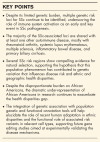Genetics of systemic sclerosis: recent advances
- PMID: 26317679
- PMCID: PMC4608482
- DOI: 10.1097/BOR.0000000000000214
Genetics of systemic sclerosis: recent advances
Abstract
Purpose of review: Large-scale and follow-up genetic association studies in systemic sclerosis (SSc) have implicated over 40 regions in disease risk, 15 of which with robust associations. Nevertheless, the causal variants and the functional mechanisms underlying the genetic associations remain elusive, and the reasons for the higher disease burden in African Americans unknown. Incorporating tools from diverse fields is beginning to unveil the role of genetic diversity and regulatory variation in SSc susceptibility. This review will summarize recent advances in SSc genetics, including autoimmune disease overlap, evidence of natural selection, and current progress towards the dissection of the functional role of associated risk variants.
Recent findings: In the past year, multiple large-scale studies reported novel strong and suggestive SSc associations. These results, coupled with the regions shared with other autoimmune diseases, emphasize the role of dysregulation of immune pathways as a key causative factor in SSc pathogenesis. Strong evidence implicates natural selection as a mechanism contributing to the maintenance of some of these SSc alleles in the population. Studies integrating genomic, transcriptomic, and epigenomic datasets in specific cell types to identify causal autoimmune disease variants are emerging.
Summary: The identification and comprehensive understanding of the factors and mechanisms contributing to SSc will contribute to improved diagnosis and disease management.
References
-
- Steen VD. The many faces of scleroderma. Rheum Dis Clin North Am 2008; 34:1–15.v. - PubMed
-
- LeRoy EC, Black C, Fleischmajer R, et al. Scleroderma (systemic sclerosis): classification, subsets and pathogenesis. J Rheumatol 1988; 15:202–205. - PubMed
-
- Barnes J, Mayes MD. Epidemiology of systemic sclerosis: incidence, prevalence, survival, risk factors, malignancy, and environmental triggers. Curr Opin Rheumatol 2012; 24:165–170. - PubMed
-
- Meier FM, Frommer KW, Dinser R, et al. Update on the profile of the EUSTAR cohort: an analysis of the EULAR Scleroderma Trials and Research group database. Ann Rheum Dis 2012; 71:1355–1360. - PubMed
Publication types
MeSH terms
Grants and funding
LinkOut - more resources
Full Text Sources
Medical
Research Materials
Miscellaneous


